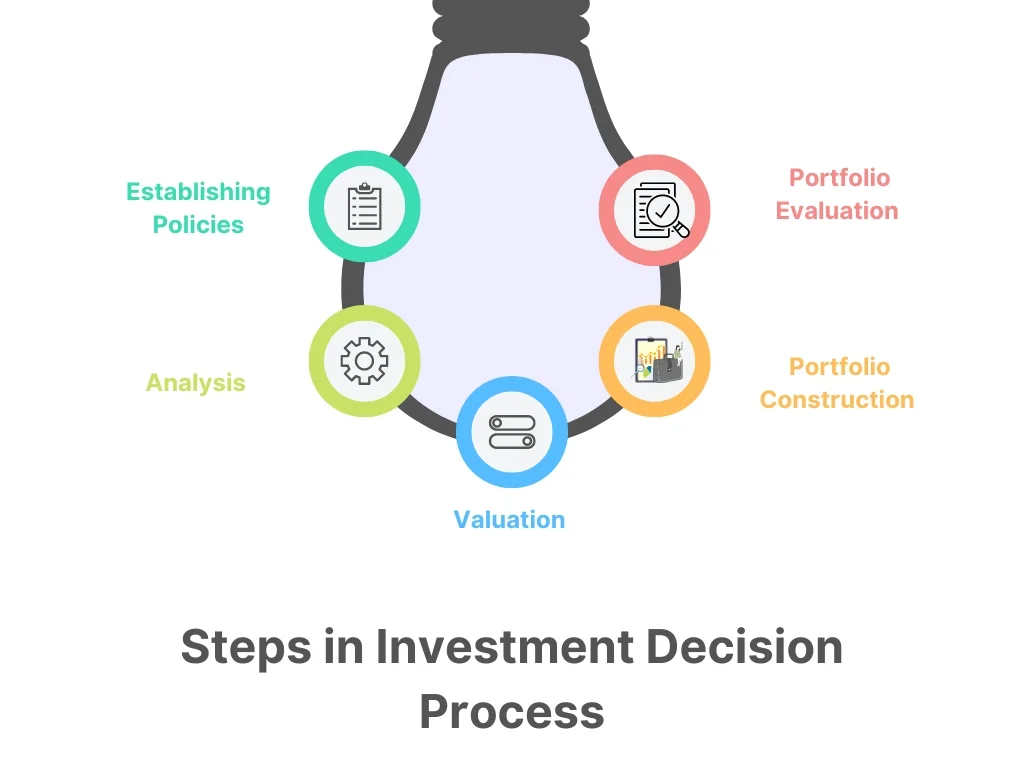Last updated on March 12th, 2024 at 02:11 am
Looking for what are the steps in investment decision process? You have reached you destination. In this article, we will study the steps in investment decision process for successful investment.
We all know that everyone is moving towards investment options for capital appreciation. The time is gone when people just invested in fixed deposits and gold. People invest in virtual assets such as stocks and bonds for a higher return on the investment.
Knowing about investing and knowing about the steps in investment decision process is a different thing. There are several factors that we need to consider before investing in an asset. As investors, we must determine certain goals and factors before investing.
Your investment goal will be the base for investment. It will help determine the type of asset the investment has to be made. What are the benefits and drawbacks of certain investments? Each factor has to be evaluated carefully. We are talking about money here; we can’t take it lightly. Each factor we study has a huge impact on the investment we make and made. Each factor has to be evaluated closely for the investment to be fruitful.
Before we study the steps in investment decision process, let us look at the basics, i.e., what is investment?
What is Investment?

Investment is the deployment of capital on assets. The capital is employed on assets with an expectation of capital appreciation. Bonds, Fixed deposits, gold investment, shares, and bonds are a few examples of assets that we can invest in.
To learn more about what investment is, read What is Investment? Objectives and 8 Important Types of Investments
Steps in Investment Decision Process
There are a total of 5 steps in investment decision process. Each process has sub-steps that have different aims we evaluate. These steps help us consider our budget, our goal, which market we should invest in, and so on. Now, let’s move on to the steps in investment decision process.

Establishing Policies
This step refers to establishing the objectives and guidelines for investments. We have to step up certain policies. These policies are to be strictly adhered to. These policies are to be set up based on the amount to be invested, the objective of the investment, and the study of the market.
Investable Capital
We have to establish how much capital has to be invested. Suppose you want to invest $100,000. Do you have the amount? 2 types of funds can be deployed for investment – Owned or borrowed. If you use your funds, the risk and return are yours. If you use borrowed capital, the returns become significantly less, but so does the risk.
Investment Objective
Next is the objective. You have to establish why you are investing. There are several reasons for investments that help us decide where to invest. Are you investing for savings and capital appreciation? Hedging against inflation? Earning income? There are several objectives that you have to decide from.
You also have to decide how much risk you are willing to take. Are you a risk-lover person? Risk moderator or a risk neglector? If you want high returns, then you have to bear high risk. Decide your risk and return capacity, then decide on your investment objective.
Knowledge of Market
Another important aspect while establishing policies is to study the market. You must ensure that you are aware of the market and market prices. You have to study various market-leading industries and companies. It would help if you learned about the market brokerage charges, how the market operates, and on what basis investments are made.
Once you have established your investment policies, the next part is analysis.
Analysis
The next step of the 5 steps in investment decision process is the analysis process. In this step, we evaluate the market, industry, and the company. It helps us to understand the market trend, i.e., whether the market is growing or declining. The most profitable would be a growing stage.

Market Analysis
First, we must conduct a market analysis. Market analysis is the study of a specific market. Generally, it refers to a market of a country. Analyzing a country’s market gives us insight into whether the market has growth potential. It shows us a trend line about where the country’s market will move further.
In market analysis, economic factors are studied to determine the market conditions. GDP, inflation, interest rate, BOP, and credit policy are some economic factors used to assess the market condition. These factors help us determine how the market can perform and whether that performance will lead to future growth.
Industry Analysis
Once you have decided on the market, next up is industry analysis. Industry refers to a group of companies that have similar business products or services. Pharmaceutical, IT, and Banking are a few examples of industry.
One main factor in Industry analysis is understanding the industry lifecycle. The industry lifecycle has 4 stages. These stages are – Introduction, Growth, Maturity, and then decline. Each stage has different earning opportunities. Industries in their growth stage offer the highest opportunities.
Company Analysis
Once you have selected the industry, it’s time to select the company to invest in. Suppose you have selected the IT industry. The next step is the look into various IT companies’ records.
In this step, we study various companies’ financial statements, dividend policies, EPS, and other financial indicators. We have to study the data and filter out the companies with higher income possibilities. Once filtered, compare the finalized companies with each other to select the company.
ALSO READ ABOUT : 3 Important Tools of Financial Statement Analysis – Definition, Types, Objectives and Limitations with example
Valuation
Once you have analyzed the companies and filtered a company, the next step in the 5 steps in investment decision process is the valuation of stock prices. In this process, well will study the share prices of the company. Not just the share prices; we evaluate all factors that can influence the prices.
Intrinsic Value
The first step in the Valuation process is to find out the company’s intrinsic value. Intrinsic value is the real value of the company by its books. This value is based on the capital assets of the company. The market prices try to match the company’s intrinsic value.
Future Value
Based on the intrinsic value, we can predict the future of the stocks. If the market value exceeds the intrinsic value, the stocks are expected to fall. The stocks are expected to rise if the market value is less than the intrinsic value.
Another method to calculate future value is by using historical data. We have to study the previous movement of stock prices. Along with that, we have to study about factors that affected the prices previously. We have to study if their effect was positive or negative.
Portfolio Construction
Portfolio construction is an important part of the steps in investment decision process. In this process, we diversify and allocate funds. It’s the step in which we invest in different companies according to our objective.

Diversification
While constructing a portfolio, it is important to make it diverse. We can diversify the investments into different markets, industries, and companies. We can also diversify our debt and equity funds. It helps us to make a less risky portfolio.
Selection
Section refers to the allocation of funds. It is the main step of the steps in investment decision process. Here, we finally deploy our capital on investments.
Portfolio Evaluation
The fifth and last step of the 5 steps in investment decision process is evaluating the progress. This process comes after we have invested. Just because we have invested does not mean that the process is done. We have to monitor the investment continuously. This is to ensure our portfolio progresses according to our investment objective.
There are 2 more steps in investment decision process while evaluating the progress. They are :
Appraisal
We have to monitor the variability of the stocks. We have to ensure that we know the factors affecting the stock prices. Not just the stock; monitor how the market is performing.
Revision
The final part of the steps in investment decision process is to revise everything. Begin from the start. Analyze all factors again.
ALSO READ ABOUT : What is Volatility in Stock Market ? 2 Important Types and Measures used for Understanding Volatility
FAQs
What are the 5 stages of investing?
The stages in investing process are –
I. Establishing Policy
II. Analysis
III. Company Valuation
IV. Portfolio construction
V. Portfolio evaluation
What are the 5 different types of investment?
Stocks
Bonds
Mutual Funds
Exchange Traded Funds
Fixed Deposits
Closing Statement
The 5 steps in investment decision process are policymaking, Analysing, valuation, portfolio construction, and evaluation. These are the ultimate steps for every investor. Wherever you are investing, these are the steps you have to follow.
Now that you know these steps in investment decision process, invest and make crazy profits.
I hope this article about the 5 steps in investment decision process is helpful. If you have any doubts, invest your time and let me know in the comment box.

